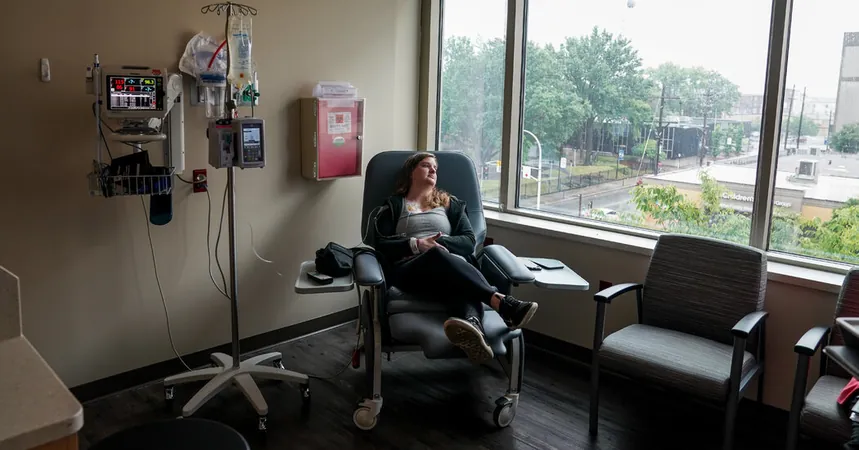
Cancer's Alarming Shift: The Rise Among Women and Young Adults
2025-01-18
Author: Yan
In a startling new report from the American Cancer Society, it is revealed that more Americans are surviving cancer than ever before. However, a troubling trend is emerging: cancer is increasingly striking young and middle-aged adults, particularly women. The findings, released on Thursday, underscore a significant departure from historical patterns in cancer incidence.
Despite the general progress in cancer survival rates, the report highlights a grim reality for many marginalized groups. Black and Native Americans are suffering disproportionately, dying from various cancers at rates two to three times higher than white Americans. This alarming statistic points to ongoing health disparities that demand immediate attention.
Traditionally, cancer has been viewed as a disease primarily affecting older adults and men. This perception is being challenged as younger individuals—especially those born since the 1950s—experience a noticeable uptick in cancer diagnoses. While smoking-related cancers and prostate cancer have seen declines, the rise of cancers like breast, uterus, and colorectal cancers marks a significant shift in the disease landscape.
Cancer remains the second leading cause of death in the U.S., surpassing all other causes among those under 85. The American Cancer Society projects an astonishing 2,041,910 new cancer cases this year, with an estimated 618,120 deaths attributed to the disease.
The New Cancer Landscape: Women Take the Hit
Of particular concern is the increase in cancers affecting women. Rebecca L. Siegel, the report’s lead author, states, “These unfavorable trends are tipped toward women.” While some cancers have seen increases among men, the rising rates among women are particularly striking and merit close observation.
One concerning revelation is the sharp rise in cervical cancer among women aged 30 to 44—an illness generally viewed as preventable. Although the use of Pap smears has significantly reduced cervical cancer rates since the 1970s, a recent Harris Poll indicates that 72% of surveyed women postponed essential health screenings, potentially leaving many at risk.
Another disturbing trend noted in the report is the first-time occurrence of lung cancer incidence in women under 65 surpassing that in men—a shocking 15.7 cases per 100,000 women compared to 15.4 among men. This rise correlates with the long-term effects of smoking, which has historically been more prevalent among men.
The Invasion of Other Cancers
Breast cancer rates are also on the rise, with a consistent increase of about 1% annually. The trend is especially pronounced in women under 50, as well as among Hispanic American, Asian American, and Pacific Islander populations. Factors contributing to this increase include delayed childbearing, hormone-driven cancers, and changes in lifestyle, such as alcohol consumption and obesity—especially concerning for older women.
Uterine cancer presents a different and worrying trend, as its survival rates have significantly dropped over the past four decades. Additionally, liver and oral cavity cancers are on the rise, raising further alarm bells among health experts.
Among the more insidious cancers, pancreatic cancer continues to grow in incidence for both men and women. It has now become the third leading cause of cancer death in the U.S. The stark challenge of pancreatic cancer lies in its late detection and the minimal advancements in treatment options, leaving the five-year survival rate at a disheartening 13%.
What Lies Beneath: The Role of Environment
Researchers are increasingly suggesting that environmental factors, alongside lifestyle choices and genetics, may be influencing the rising cancer rates among younger populations. Dr. Neil Iyengar from Memorial Sloan Kettering Cancer Center posits, “The rise in a variety of cancers among young people, especially young women, suggests there is something broader going on.” He emphasizes the need for further investigation into the role of lifestyle and environmental variables in cancer development.
Public health initiatives have traditionally targeted older Americans and those with known risk factors, but the factors contributing to cancer risk in younger individuals may differ and require tailored approaches.
As the landscape of cancer evolves, it becomes critical for both individuals and public health entities to recognize and respond to these shifting trends, ensuring that no demographic is left behind in the fight against this devastating disease. The urgent need for prevention strategies, early detection, and advocacy for at-risk groups has never been clearer. Let’s join the conversation on how we can address these rising statistics and work towards a healthier future for all.


 Brasil (PT)
Brasil (PT)
 Canada (EN)
Canada (EN)
 Chile (ES)
Chile (ES)
 Česko (CS)
Česko (CS)
 대한민국 (KO)
대한민국 (KO)
 España (ES)
España (ES)
 France (FR)
France (FR)
 Hong Kong (EN)
Hong Kong (EN)
 Italia (IT)
Italia (IT)
 日本 (JA)
日本 (JA)
 Magyarország (HU)
Magyarország (HU)
 Norge (NO)
Norge (NO)
 Polska (PL)
Polska (PL)
 Schweiz (DE)
Schweiz (DE)
 Singapore (EN)
Singapore (EN)
 Sverige (SV)
Sverige (SV)
 Suomi (FI)
Suomi (FI)
 Türkiye (TR)
Türkiye (TR)